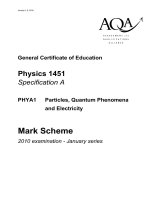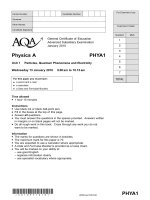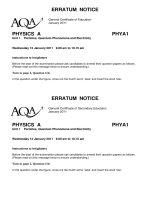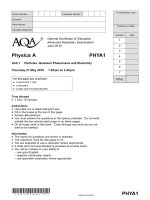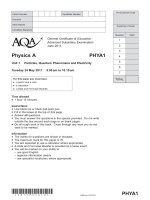- Trang chủ >>
- Khoa Học Tự Nhiên >>
- Vật lý
Vật lý A level: AQA PHYA5 2d QP JUN12
Bạn đang xem bản rút gọn của tài liệu. Xem và tải ngay bản đầy đủ của tài liệu tại đây (427.48 KB, 12 trang )
(JUN12PHYA52D01)
WMP/Jun12/PHYA5/2D
PHYA5/2D
Centre Number
Surname
Other Names
Candidate Signature
Candidate Number
General Certificate of Education
Advanced Level Examination
June 2012
Time allowed
l
The total time for both sections of this paper is 1 hour 45 minutes.
You are advised to spend approximately 50 minutes on this section.
Instructions
l
Use black ink or black ball-point pen.
l
Fill in the boxes at the top of this page.
l
Answer all questions.
l
You must answer the questions in the spaces provided. Do not write
outside the box around each page or on blank pages.
l
Do all rough work in this book. Cross through any work you do not
want to be marked.
l
Show all your working.
Information
l
The marks for questions are shown in brackets.
l
The maximum mark for this section is 35.
l
You are expected to use a calculator where appropriate.
l
A Data and Formulae Booklet is provided as a loose insert.
l
You will be marked on your ability to:
– use good English
– organise information clearly
– use specialist vocabulary where appropriate.
For this paper you must have:
l
a calculator
l
a ruler
l
a Data and Formulae Booklet (enclosed).
Physics A PHYA5/2D
Unit 5D Turning Points in Physics
Section B
Monday 18 June 2012 9.00 am to 10.45 am
MarkQuestion
For Examinerʼs Use
Examinerʼs Initials
TOTAL
1
2
3
4
WMP/Jun12/PHYA5/2D
Do not write
outside the
box
Section B
The maximum mark for this section is 35 marks. You are advised to spend approximately
50 minutes on this section.
1 A narrow beam of electrons is directed into the region between two parallel plates,
P and Q. When a constant potential difference is applied between the two plates, the
beam curves downwards towards plate Q as shown in Figure 1.
Figure 1
1 (a) Explain why the beam curves downwards at an increasing angle to its initial direction.
(3 marks)
1 (b) A uniform magnetic field is then applied at right angles to both the beam and the
electric field between the plates P and Q. As a result, the downward deflection of the
beam is increased.
1 (b) (i) The arrangement is to be used to determine the speed of the electrons in the beam.
Describe what adjustments to the flux density B of the magnetic field should be made
to reduce the deflection of the beam to zero.
(1 mark)
(02)
2
beam of electrons
P
Q
–
+
WMP/Jun12/PHYA5/2D
Tur n over
ᮣ
(03)
Do not write
outside the
box
1 (b) (ii) Explain why the electrons pass undeflected through the fields when their speed v is
given by
v = –––
where V is the potential difference between plates P and Q and d is the perpendicular
distance between the plates.
(2 marks)
1 (c) The beam of electrons was produced by thermionic emission from a heated filament.
When the potential difference between the anode and the filament was 4200V, the
speed of the electrons in the beam was 3.9 × 10
7
ms
–1
.
Use this information to determine the specific charge of the electron.
answer = C kg
–1
(3 marks)
3
9
V
Bd
WMP/Jun12/PHYA5/2D
Do not write
outside the
box
2 (a) Describe, in terms of electric and magnetic fields, a plane polarised electromagnetic
wave travelling in a vacuum. You may wish to draw a labelled diagram.
(3 marks)
2 (b) In his theory of electromagnetic waves, Maxwell predicted that the speed of all
electromagnetic waves travelling through free space is given by
c = ––––––
where μ
o
is the permeability of free space and ε
o
is the permittivity of free space.
Explain why this prediction led to the conclusion that light waves are electromagnetic
waves.
(2 marks)
4
(04)
1
√μ
o
ε
o
WMP/Jun12/PHYA5/2D
Tur n over
ᮣ
(05)
9
Do not write
outside the
box
5
2 (c) Hertz discovered how to produce and detect radio waves. Figure 2 shows a transmitter
of radio waves, T, and a detector D. The detector loop and the transmitter aerial are in
the same vertical plane.
Figure 2
2 (c) (i) Explain why an alternating emf is induced in the loop when it is in this position.
(3 marks)
2 (c) (ii) Explain why an alternating emf cannot be detected if the detector loop is turned
through 90
o
about the axis XY.
(1 mark)
X Y
D
T
WMP/Jun12/PHYA5/2D
Do not write
outside the
box
3 (a) Light has a dual wave-particle nature. State and outline a piece of evidence for the
wave nature of light and a piece of evidence for its particle nature. For each piece of
evidence, outline a characteristic feature that has been observed or measured and give a
short explanation of its relevance to your answer. Details of experiments are not
required.
The quality of your written communication will be assessed in your answer.
(6 marks)
6
(06)
WMP/Jun12/PHYA5/2D
(07)
Do not write
outside the
box
3 (b) An electron is travelling at a speed of 0.890c where c is the speed of light in free
space.
3 (b) (i) Show that the electron has a de Broglie wavelength of 1.24 × 10
–12
m.
(2 marks)
3 (b) (ii) Calculate the energy of a photon of wavelength 1.24 × 10
–12
m.
answer = J
(1 mark)
3 (b) (iii) Calculate the kinetic energy of an electron with a de Broglie wavelength
of 1.24 × 10
–12
m.
Give your answer to an appropriate number of significant figures.
answer = J
(2 marks)
7
Tur n over
ᮣ
11
WMP/Jun12/PHYA5/2D
Do not write
outside the
box
4 Figure 3 represents the Michelson-Morley interferometer. Interference fringes are seen
by an observer looking through the viewing telescope.
Figure 3
4 (a) Explain why the interference fringes shift their position if the distance from either of the
two mirrors to the semi-silvered block is changed.
(2 marks)
8
(08)
monochromatic
light source
semi-silvered
glass block
plane glass block
plane mirror M
2
plane mirror M
1
viewing telescope
observer
WMP/Jun12/PHYA5/2D
Do not write
outside the
box
4 (b) Michelson and Morley predicted that the interference fringes would shift when the
apparatus was rotated through 90
o
. When they tested their prediction, no such fringe
shift was observed.
4 (b) (i) Why was it predicted that a shift of the fringes would be observed?
(3 marks)
4 (b) (ii) What conclusion was drawn from the observation that the fringes did not shift?
(1 mark)
END OF QUESTIONS
9
(09)
6
WMP/Jun12/PHYA5/2D
10
(10)
There are no questions printed on this page
DO NOT WRITE ON THIS PAGE
ANSWER IN THE SPACES PROVIDED
WMP/Jun12/PHYA5/2D
(11)
11
There are no questions printed on this page
DO NOT WRITE ON THIS PAGE
ANSWER IN THE SPACES PROVIDED
WMP/Jun12/PHYA5/2D
(12)
12
There are no questions printed on this page
DO NOT WRITE ON THIS PAGE
ANSWER IN THE SPACES PROVIDED
Copyright © 2012 AQA and its licensors. All rights reserved.

